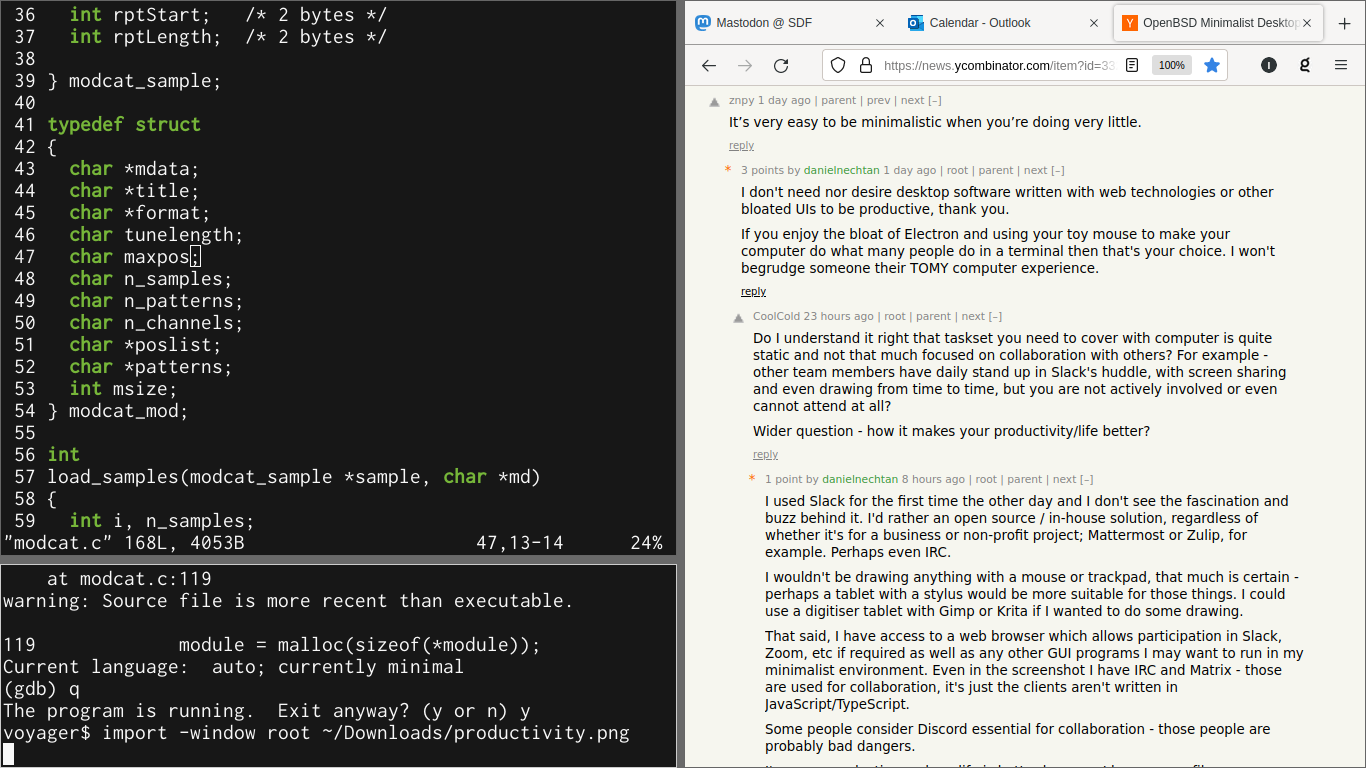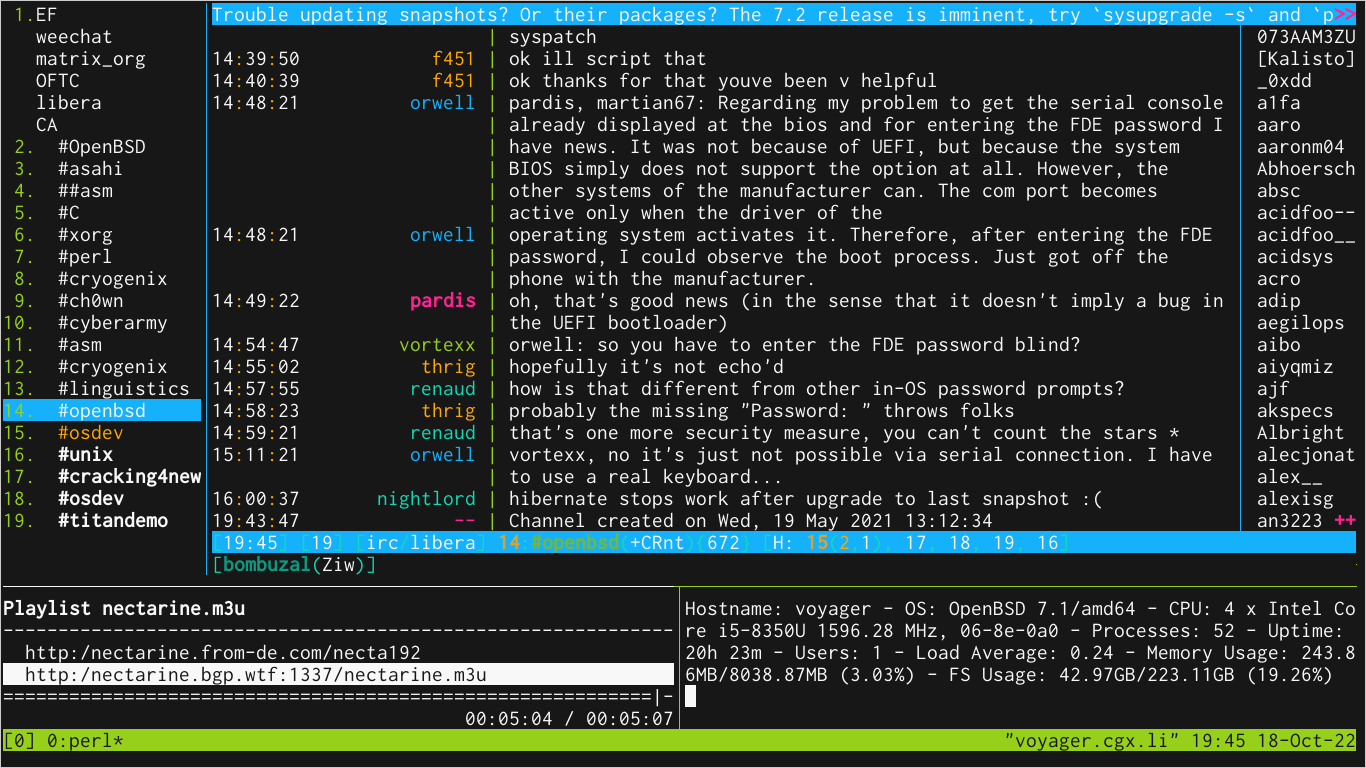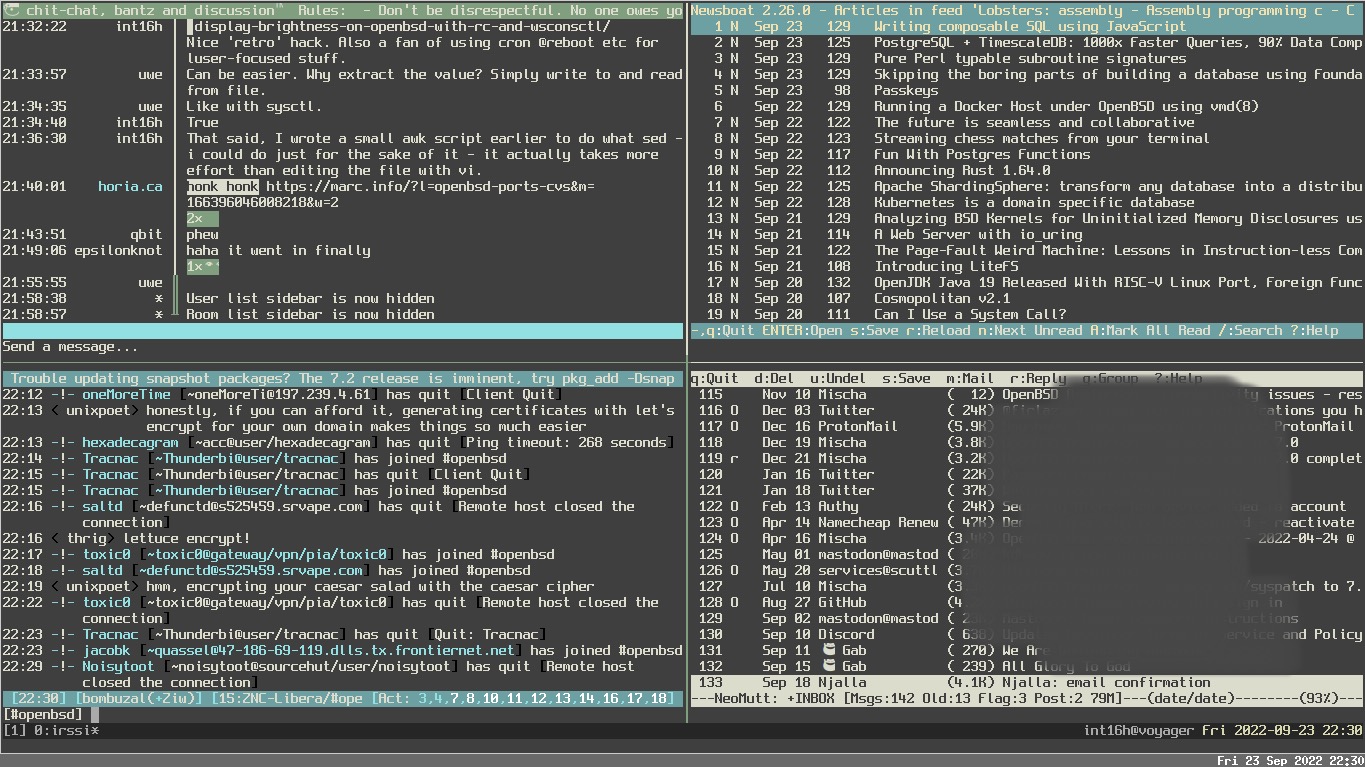WARNING: This article is a few years old but has been updated slightly to reflect OpenBSD 7.7. There may be bugs!
OpenBSD's support for modern hardware continues to excel, you can even run OpenBSD on Apple's M1/M2 Macbooks today and it's my go-to OS on small X-series Thinkpads.
I was going to update the previous article but as my own habits have changed quite a lot and are more in line with the spirit of the OpenBSD base, it seemed like a new article was warranted. I may update this article in the future with 'rice' for cwm(1) (including Xresources, etc) but at present this is a basic guide to getting a generic desktop system up and running.
It is customary when mentioning any command, file, or topic that has a manual page to include which manual it's included in. So when you see cwm(1) - I am referring to cwm in the General Commands manual, which is manual 1. To read that manual page, type: man 1 cwm (though man cwm will default to cwm(1)).
Hardware: Lenovo Thinkpad X280 (8GB RAM / 256GB NVMe / Intel Wifi)
Grab install77.img from https://cdn.openbsd.org/pub/OpenBSD/7.7/amd64/ and write it to a USB flash disk with a USB writer such as Rufus if using Windows or, On a Unix-like operating system, dd(1) can be used to accomplish this - on GNU/Linux, for example:
dd if=install71.img of=/dev/sdb bs=1M
When installing OpenBSD I always use softraid(8) CRYPTO to encrypt my system. Instructions to do this are in the OpenBSD FAQ, however, support for encrypting your disk through the installer is now available.
The default disklabel(8) layout is recommended for most situations, however, if you will be compiling a lot of ports you may want to edit the default layout to make more space in /usr/src and /usr/obj; here is what I ended up with:
OpenBSD area: 1024-500116574; size: 238.5G; free: 0.0G
# size offset fstype [fsize bsize cpg]
a: 1.0G 1024 4.2BSD 2048 16384 12960 # /
b: 8.1G 2098176 swap # none
c: 238.5G 0 unused
d: 16.0G 19086080 4.2BSD 2048 16384 12960 # /tmp
e: 20.0G 52644992 4.2BSD 2048 16384 12960 # /var
f: 10.0G 94590720 4.2BSD 2048 16384 12960 # /usr
g: 4.0G 115571584 4.2BSD 2048 16384 12960 # /usr/X11R6
h: 30.0G 123973600 4.2BSD 2048 16384 12960 # /usr/local
i: 0.0G 64 MSDOS
j: 12.0G 186900192 4.2BSD 2048 16384 12960 # /usr/src
k: 16.0G 212074048 4.2BSD 2048 16384 12960 # /usr/obj
l: 121.3G 245633824 4.2BSD 2048 16384 12960 # /home
Firmware and networking
OpenBSD detects the iwm(8) 802.11x wireless device but will need the firmware for it to be functional. If you have a supported USB adapter or Lenovo's adapter cable for the built-in em(8) ethernet device you can skip the following step as OpenBSD will run fw_update(8) on first boot if your network is configured correctly.
On another computer with network access, format a USB disk as FAT and copy everything from http://firmware.openbsd.org/firmware/7.7/ onto it. I find the easiest way to grab these files on a non-OpenBSD system is to install and use lftp:
$ lftp http://firmware.openbsd.org/firmware/7.7/
cd ok, cwd=/firmware/7.7
lftp firmware.openbsd.org:/firmware/7.7> mget *
Unmount the disk and keep it for the first boot after installation.
First boot
Login as root or preferably the user created during installation and su - (substitute user to root).
Install any updates and merge changes to configuration files.
# syspatch
# sysmerge -d
Firmware
Insert your USB disk with the firmware, mount it, copy the firmware over and install it:
# dmesg | grep sd
# mount_msdos /dev/sd3i /mnt
# mkdir /home/firmware
# cp /mnt/firmware/* /home/firmware/
# mv /home/firmware/SHA256.SIG /home/firmware/SHA256.sig
# fw_update -p /home/firmware/
Connecting to Wifi
If you skipped setting up wifi during installation, you can do so now by editing hostname.if(5), where if is your wifi interface. Running ifconfig(8) can help you identify the interface. For Intel 7000-9000 based cards such as on this Thinkpad, the device is iwm0.
/etc/hostname.iwm0:
join somewifinet wpakey mywpapassphrase
inet autoconf
Performance
On a workstation, I recommend to disabling the updating of atime (access time) on filesystems with heavy usage such /home where performance is more important than maintaining accurate file access times.
Edit /etc/fstab and add noatime after rw on the home partition line (don't forget the comma!).
It is also desirable, especially on a laptop, to have the Advanced Power Management daemon running in automatic mode.
# rcctl enable apmd
# rcctl set apmd flags -A
Solene maintains a userland CPU frequency scheduler called obsdfreqd(1) which works really well, particularly on my Thinkpads - it's available as a pkg but more information about it can be found at https://git.sr.ht/~solene/obsdfreqd
If you decide to use it, don't forget to change apmd to manual mode (-L).
Xenocara / xenodm(1)
Xenocara is OpenBSD's infrastructure for the X(7).org Server and window managers included in base - cwm(1) and fvwm(1).
xenodm(1) is the X(1) Display Manager which manages access to the Xserver(1), providing a graphical login interface.
By default, xconsole(1) is started by xenodm(1) and the background set to the familiar (and perhaps ugly) root weave pattern. We can easily remove these in /etc/X11/xenodm/Xsetup_0, have the background set to a solid dark grey colour and disable the system bell:
# sed -i '/${exec/s/^/#/g' /etc/X11/xenodm/Xsetup_0
# PREF="\${exec_prefix}/bin" &&
echo "$PREF/xsetroot -solid dimgrey\n$PREF/xset b off\n" >> /etc/X11/xenodm/Xsetup_0
Add your user to staff and doas.conf(5)
It's not recommended to normally login as the root user. For a long time, Unix-like operating systems relied on sudo to perform operations as another user (such as root); in 2015 Ted Unangst developed doas(1) for OpenBSD as a safer and simpler replacement.
Let's allow any user in the wheel group(5) to execute commands as root with doas(1):
# echo "permit :wheel" >> /etc/doas.conf
In addition to groups such as wheel, OpenBSD (like other BSD operating systems) maintains a login class capability database that is configured in login.conf(5). This allows fine-tuning of resources for users and processes in a robust yet simple way. On a desktop or laptop, the user we created is probably going to be our only human user so we should add it to the staff class and increase resources to ensure we can use the system as a daily driver:
# usermod -L staff myuser
# usermod -G staff myuser
In `/etc/login.conf' update the staff class as follows using vi(1):
staff:\
:datasize-cur=4096M:\
:datasize-max=infinity:\
:maxproc-max=512:\
:maxproc-cur=256:\
:openfiles-cur=4096:\
:openfiles-max=4096:\
:ignorenologin:\
:requirehome@:\
:tc=default:
You should increase datasize-cur depending on your total memory. 4096M works relatively well for 8GB though I have noticed with excessive web browser use that things can freeze up. Likewise, openfiles-cur/max should be increased depending on your needs. If you run Syncthing or work with large Bittorrent files for example you will probably want to increase that to an insane amount and replicate it in /etc/sysctl.conf(5): kern.maxfiles.
Rebuild the database:
cap_mkdb /etc/login.conf
Kernel settings
Here are some recommended sysctl(2) values (based on this system) for a desktop to add to /etc/sysctl.conf(5):
cat <<EOF > /etc/sysctl.conf
kern.maxproc=4096
kern.maxthread=4096
kern.maxfiles=32768
EOF
If you're not worried about side-channel attacks on SMT (Simultaneous MultiThreading) you can also add hw.smt=1 to sysctl.conf to enable multithreading - a significant performance boost if you're fine with the risks!
X Session
To enable tap-to-click on the trackpad:
# echo "mouse.tp.tapping=1" >> /etc/wsconsctl.conf
Now exit then login as your regular user and create .xsession in your home directory with the following:
# Set your locale(1)
export LANG=en_US.UTF-8
# Set your environment (korn shell)
export ENV=$HOME/.kshrc
# No core dumps!
ulimit -Sc 0
# Merge our X resources
xrdb -merge $HOME/.Xresources
# Set background colour
setroot -solid dimgrey
# Make sure that bell is off!
xset b off
# Use Capslock as CTRL
setxkbmap -option ctrl:nocaps
# Run xterm
xterm &
# Fix scaling of some X/QT programs - this has a low-resolution/DPI screen so adjust as required
xrandr --dpi 96
# Automatically lock X and run a classic screensaver
xidle -delay 5 -sw -timeout 300 -program "/usr/X11R6/bin/xlock -mode qix" &
# Run our window manager.
# Can later be replaced with `exec startxfce4` if desired.
# exec runs it in the foreground - X will exit when the cwm proc exits.
exec cwm
At this point we should reboot(8) - then we can benefit from our disk performance tweaks which you will be thankful for when installing packages.
Customisation
Let's install some packages, adjusting to your own taste:
$ doas pkg_add ImageMagick \
bzip2 \
git \
gnupg \
firefox \
mpv \
inconsolata-font \
spleen \
ffmpeg \
unzip \
keepassxc \
weechat \
picom \
mupdf \
cplay \
cmus \
newsboat \
neomutt \
vim
If you would prefer a more familiar desktop environment, xfce can be installed:
$ doas pkg_add xfce xfce-extras xfce4-power-manager upower xscreensaver
Then in .xsession, replace exec cwm with exec startxfce4 and remove the xidle and xterm lines.
Xresources
You could write a book, or at least a pamphlet, on styling X(7) but the following ~/.Xresources file will at least get you started with a prettier xterm(1) to use in cwm(1):
*visualBell: True
xterm.loginShell: true
xterm*faceName: Inconsolata:size=16
! xterm*dynamicColors: true
xterm*utf8: 2
xterm*eightBitInput: true
xterm*scrollBar: false
! xterm*foreground: rgb:a8/a8/a8
! xterm*background: rgb:00/00/00
*background : #171717
*foreground : #F8F8F8
! black
*color0 : #171717
*color8 : #38252C
! red
*color1 : #D81765
*color9 : #FF0000
! green
*color2 : #97D01A
*color10 : #76B639
! yellow
*color3 : #FFA800
*color11 : #E1A126
! blue
*color4 : #16B1FB
*color12 : #289CD5
! magenta
*color5 : #FF2491
*color13 : #FF2491
! cyan
*color6 : #0FDCB6
*color14 : #0A9B81
! white
*color7 : #EBEBEB
*color15 : #F8F8F8
cwmrc(5)
A minimal ~/.cwmrc configuration:
fontname "Inconsolata:pixelsize=14:bold"
sticky yes
snapdist 20
command firefox firefox
command newsboat "xterm -e newsboat"
command keepassxc keepassxc
bind-key 4-Return terminal
bind-key CM-Return "xterm -e top"
bind-key C4-equal window-vmaximize
bind-key C4S-equal window-hmaximize
bind-key 4-1 group-only-1
bind-key 4-2 group-only-2
bind-key 4-3 group-only-3
bind-key C4-1 window-movetogroup-1
bind-key C4-2 window-movetogroup-2
bind-key C4-3 window-movetogroup-3
bind-key M-j window-cycle
bind-key M-k window-cycle
bind-key M-t window-maximize
bind-key M-v window-vtile
bind-key 4-b "xbacklight -dec 10 -time 0"
bind-key 4S-b "xbacklight -inc 10 -time 0"
cwm(1) can take some getting used to if you are more accustomed to a traditional desktop environment but with a little effort to learn to use it efficiently you will find it increases your productivity and decreases your dependence on the mouse or trackpad.
In the above example, pressing WINDOWS+Return will spawn a terminal.
Miscellaneous
If you have performance issues in Firefox, in the navigation bar type: about:config enter then search for and enable this option:
layers.acceleration.force-enable=true
You may notice in some programs such as Firefox CTRL-A doesn't select all text. I nicked this snippet from Callum Smith of c0ffee.net which remedies that by creating and adding the following to ~/config/gtk-3.0/settings.ini:
[Settings]
gtk-key-theme-name=Default
That's it, a very minimal base on which to expand and enjoy OpenBSD - it works particularly well on these tiny X-series Thinkpads.
Written for Cryogenix by int16h



